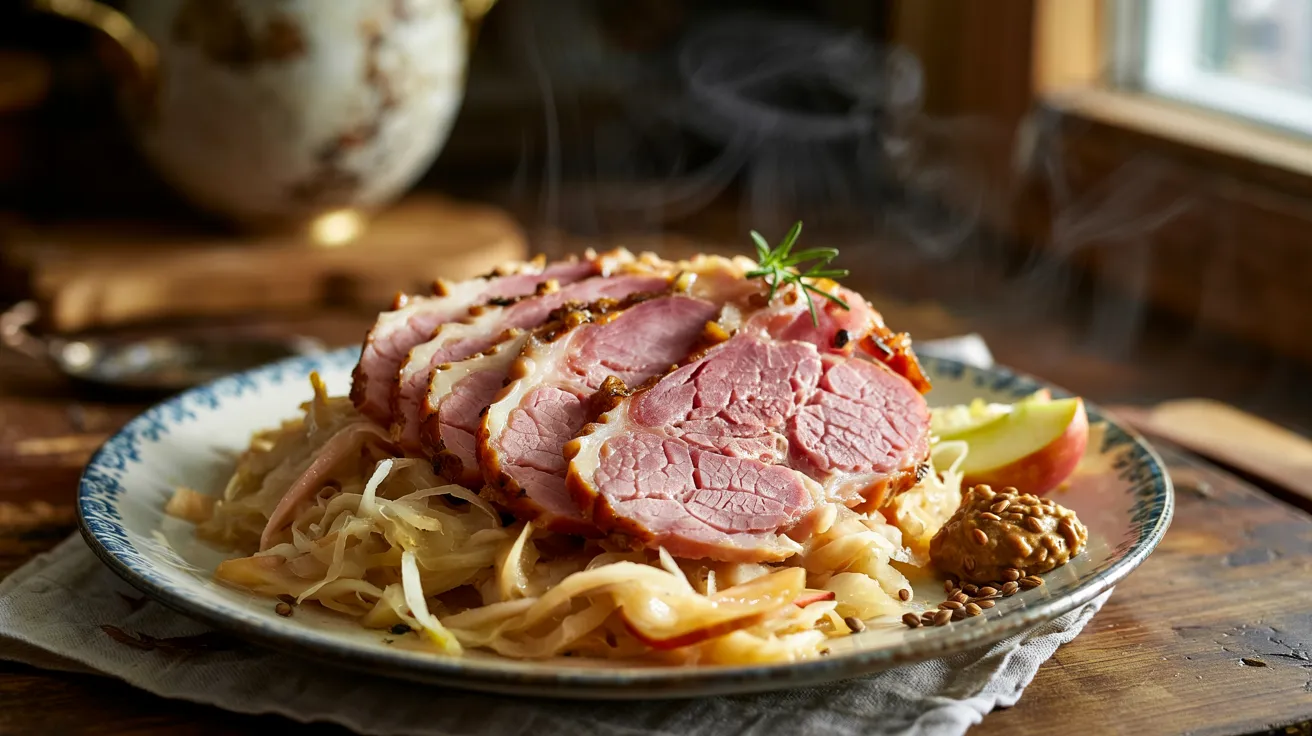Prep Time: 15 minutes | Cook Time: 45 minutes | Total Time: 1 hour | Serves: 4
Key Takeaways:
- Master this Classic German Ham and Sauerkraut Recipe in just 1 hour
- Learn the chef’s trick to balance tang and smoke perfectly
- Discover how to avoid common beginner mistakes
- Impress guests with authentic German flavor at home
Why This Classic German Ham and Sauerkraut Recipe Works
Ever tried making a Classic German Ham and Sauerkraut Recipe only to end up with something too sour or too bland? I’ve been there too. This traditional dish seems simple, but getting that perfect balance can be tricky.
The secret lies in how you prepare both the ham and the sauerkraut. Many home cooks skip crucial steps that restaurant chefs always follow. I’ll show you exactly how to nail this Classic German Ham and Sauerkraut Recipe with techniques I learned from my German grandmother.
Whether you’re making this for a cozy Sunday dinner or honoring the New Year’s tradition, this recipe delivers that authentic taste you’re craving. By following these specific steps, you’ll create a dish that’s miles better than any restaurant version.
Nutrition Facts Per Serving
| Nutrient | Amount | % Daily Value |
|---|---|---|
| Calories | 410 | – |
| Protein | 32g | 64% |
| Fat | 24g | 31% |
| Carbs | 14g | 5% |
| Fiber | 8g | 29% |
| Sodium | 1450mg | 63% |
| Vitamin C | 35mg | 39% |
| Iron | 3mg | 17% |
What You’ll Need for Your Classic German Ham and Sauerkraut Recipe
Ingredients
| Ingredient | Amount | Notes |
|---|---|---|
| Bone-in ham | 2 pounds | Cut into 1-inch cubes |
| Sauerkraut | 32 ounces | Fresh or packaged |
| Pork lard | 2 tablespoons | Or butter as substitute |
| Yellow onion | 1 large | Diced |
| Garlic | 2 cloves | Minced |
| Chicken broth | 1 cup | Low-sodium preferred |
| Caraway seeds | 1 teaspoon | Essential for authentic flavor |
| Black pepper | 1/2 teaspoon | Freshly ground |
| Salt | To taste | Start with 1/4 teaspoon |
| Apple (optional) | 1 medium | Diced |
| Brown sugar (optional) | 1 tablespoon | For balancing acidity |
| Bay leaf (optional) | 1 | Removed before serving |
Kitchen Tools
| Tool | Purpose |
|---|---|
| Dutch oven or large pot | Main cooking vessel |
| Colander | Draining sauerkraut |
| Sharp chef’s knife | Cutting ham and veggies |
| Cutting board | Prep surface |
| Measuring cups/spoons | Accurate measurements |
| Wooden spoon | Stirring without scratching |
| Paper towels | Drying ham |
| Timer | Track cooking time |
Super-Detailed Step-by-Step Instructions for Classic German Ham and Sauerkraut Recipe
Before You Begin (5 minutes)
- Read Through the Entire Recipe Once:
- Familiarize yourself with all steps before starting
- Check that you have all ingredients and tools
- Clear counter space for prep work
- Beginner’s Tip: Place all ingredients on the counter to ensure nothing is missing
- Preheat Your Cooking Vessel:
- Place Dutch oven on stove
- Set to medium-low heat to begin warming up
- Beginner’s Tip: A preheated pot provides more even cooking
Preparation Phase (15 minutes)
- Prepare the Sauerkraut:
- Set a colander in your sink or in a large bowl
- Open the package(s) of sauerkraut (32 ounces total)
- Pour the entire contents into the colander
- Allow liquid to drain for 1-2 minutes
- Gently shake the colander to help release more liquid
- If you prefer milder flavor, run cold water over sauerkraut for 30 seconds
- Use your hands or the back of a large spoon to gently press down
- Press just enough to remove excess liquid but not completely dry
- Place drained sauerkraut in a bowl and set aside
- Beginner’s Tip: The liquid from sauerkraut is very acidic – wash hands after handling
- Prepare the Ham:
- Place ham on a clean cutting board
- Identify any large pieces of white fat on the edges
- Using your knife, carefully trim off excess fat pieces
- Cut ham into 1-inch cubes (approximately the size of a sugar cube)
- Try to make cubes uniform in size for even cooking
- Take several paper towels and pat each ham piece until dry
- Set ham pieces on a plate near your stove
- Beginner’s Tip: Wet ham will steam rather than brown – drying is essential
- Prepare the Vegetables and Spices:
- Peel the onion and cut off the ends
- Cut the onion in half from top to bottom
- Place each half flat-side down on cutting board for stability
- Cut into thin slices, then rotate and dice into small pieces (about ¼ inch)
- For garlic cloves, remove papery skin completely
- Either use a garlic press or:
- Place flat side of knife blade on garlic and press down firmly to crush
- Mince the crushed garlic into very small pieces
- Measure out all spices into separate small bowls:
- 1 teaspoon caraway seeds
- ½ teaspoon black pepper
- Measure 1 cup chicken broth and set aside
- Beginner’s Tip: Organizing all ingredients before cooking (called “mise en place”) makes the cooking process much smoother
Cooking Phase (45 minutes)
- Create the Flavor Base (10 minutes):
- Increase heat under Dutch oven to medium
- Add 2 tablespoons pork lard (or butter if substituting)
- Wait until lard is completely melted and shimmering (2-3 minutes)
- Add all the diced onions to the pot
- Stir with wooden spoon to coat onions evenly in fat
- Cook onions, stirring occasionally (every 1-2 minutes)
- Watch for onions to become translucent (see-through) – about 5-7 minutes
- Add the minced garlic
- Stir constantly for exactly 1 minute (set a timer!)
- Beginner’s Tip: Garlic burns easily and becomes bitter – if it starts browning too quickly, immediately reduce heat and proceed to next step
- Brown the Ham (10 minutes):
- Add ham cubes to the pot with onions and garlic
- Spread into a single layer if possible
- Let ham cook without stirring for 2-3 minutes
- Check the bottom of several pieces – they should be turning golden brown
- Using wooden spoon, gently turn each piece to brown on another side
- Cook for another 2-3 minutes
- Continue turning occasionally until most sides have some color
- Beginner’s Tip: If your pot is not large enough, brown ham in two batches – overcrowded meat will steam instead of brown
- Combine All Ingredients (5 minutes):
- Add drained sauerkraut to the pot with ham and onions
- Pour in the 1 cup of chicken broth evenly over everything
- Sprinkle the caraway seeds evenly across the surface
- Add the black pepper
- Using your wooden spoon, gently mix everything together
- Make sure to scrape the bottom of the pot to incorporate any browned bits
- These browned bits contain intense flavor
- Beginner’s Tip: Be gentle when stirring to avoid breaking up the sauerkraut strands too much
- Simmer the Classic German Ham and Sauerkraut Recipe (20-25 minutes):
- Wait for the liquid to start bubbling (about 2-3 minutes)
- Once bubbling, reduce heat to medium-low
- Put the lid on your Dutch oven
- Set a timer for 20 minutes
- At the 7-minute mark, carefully remove lid (away from face to avoid steam)
- Stir gently but thoroughly
- Replace lid and continue cooking
- At the 14-minute mark, stir again
- Replace lid and finish cooking
- Beginner’s Tip: The liquid should be gently bubbling – if it’s boiling vigorously, reduce heat further
- Final Adjustments and Resting (5 minutes):
- After 20 minutes of simmering, remove the lid
- Check the consistency – there should be some liquid but not soupy
- If too wet, simmer uncovered for 3-5 minutes
- If too dry, add ¼ cup more broth
- Turn off heat completely
- Allow a spoonful to cool for 30 seconds
- Taste and adjust seasoning:
- Need more salt? Add ¼ teaspoon, stir, and taste again
- Too sour? Add 1 tablespoon brown sugar, stir well
- Let the entire dish rest uncovered for 5 minutes
- Beginner’s Tip: The flavors will continue to develop and meld during the resting period
Serving Your Classic German Ham and Sauerkraut Recipe
- Proper Serving Technique:
- Stir gently one final time
- Use a large spoon to portion into bowls
- Include both solids and cooking liquid
- Make sure each serving has a good balance of ham and sauerkraut
- Serve immediately while hot
- Beginner’s Tip: This dish pairs wonderfully with rye bread or boiled potatoes on the side
Visual Cues for Success:
- Onions should be soft and translucent, not dark brown or burnt
- Ham should have golden-brown edges but still be juicy
- Final dish should have enough liquid to be moist but not soupy
- Sauerkraut should be tender but still have distinct strands
- The color should be golden to light brown throughout
- You should see specks of caraway seeds distributed throughout
Common Beginner Mistakes to Avoid with Classic German Ham and Sauerkraut Recipe:
- Not drying ham properly before browning
- Adding all ingredients at once instead of building flavors
- Cooking at too high temperature, causing burning
- Not stirring occasionally during simmering
- Adding too much salt before tasting (ham and sauerkraut are already salty)
- Overcooking until sauerkraut loses all texture
Safety Reminders:
- Always wash hands after handling raw meat
- Use separate cutting boards for meat and vegetables
- Keep pot handles turned inward on stove to prevent accidental knocking
- Use oven mitts when handling hot lids
- Let food cool slightly before tasting to avoid burns
- Store leftovers within 2 hours of cooking

Troubleshooting Guide for Classic German Ham and Sauerkraut Recipe
| Problem | Solution |
|---|---|
| Too Sour | Add 1 diced apple or 1 tablespoon brown sugar, simmer 5 more minutes |
| Too Dry | Add more chicken broth, ¼ cup at a time, allowing to simmer briefly |
| Too Wet | Simmer uncovered for 5-10 minutes to reduce liquid |
| Ham Too Salty | Skip adding extra salt, add 1 diced potato to absorb salt |
| Bland Taste | Add more caraway seeds (½ teaspoon at a time) or ¼ teaspoon garlic powder |
| Burnt Bottom | DON’T scrape the burnt part; carefully transfer to new pot without burnt bits |
Variations & Substitutions for Classic German Ham and Sauerkraut Recipe
If you love this classic recipe, you might also enjoy my other creative ham dishes that use similar techniques but with delicious twists.
- Meat Options:
- Smoked kielbasa sliced into rounds
- Black forest ham cubes
- Smoked pork chops cut into strips
- Bacon-ham combination (¼ pound bacon + 1½ pounds ham)
- Healthier Version:
- Replace pork lard with olive oil or avocado oil
- Use turkey ham instead of pork
- Add extra vegetables for more nutrients
- Use low-sodium broth and don’t add salt
- Extra Flavor Boosters:
- Add 1 diced apple for sweetness
- Include 5-6 juniper berries (remove before serving)
- Mix in 1 tablespoon whole grain mustard
- Add 2 tablespoons apple cider for brightness
- Vegetable Add-ins:
- 1 cup diced carrots (add with onions)
- 1 cup diced potatoes (add after browning ham)
- ½ cup diced celery for extra crunch
- 1 bay leaf (remove before serving)
For a simpler side dish that pairs perfectly with this recipe, try my fried cabbage and ham recipe – it uses many of the same ingredients but comes together even faster.
Storage & Reheating Instructions for Classic German Ham and Sauerkraut Recipe
- Refrigerator Storage:
- Allow to cool completely before storing
- Transfer to airtight container
- Keeps well for up to 4 days
- Flavors often improve after 24 hours!
- Freezer Storage:
- Use freezer-safe container with tight seal
- Leave ½ inch space at top for expansion
- Label with date and contents
- Keeps well for up to 3 months
- Thawing Frozen Leftovers:
- Move from freezer to refrigerator 24 hours before needed
- Never thaw at room temperature (safety risk)
- If in a hurry, place sealed container in cold water bath
- Reheating Methods:
- Stovetop (Best Method): Place in pan with 2-3 tablespoons broth, heat on medium-low with occasional stirring until internal temperature reaches 165°F (about 5-7 minutes)
- Microwave: Place portion in microwave-safe dish, cover loosely, heat on medium power (70%) for the first 2 minutes, stir, then heat in 1-minute intervals until hot throughout
Safety Notes & Final Tips for Classic German Ham and Sauerkraut Recipe
This dish makes a fantastic pairing with corn bread – check out my corn and ham recipe for a complete meal your family will love.
- Always check ham’s internal temperature reaches 145°F for initial cooking
- When reheating, ensure food reaches 165°F throughout
- Don’t leave cooked dish at room temperature for more than 2 hours
- Don’t refreeze previously frozen ham
- Keep leftovers refrigerated promptly after meal
- Use clean utensils each time you serve
Pro Tips for Perfect Classic German Ham and Sauerkraut Recipe
- Look for sauerkraut in the refrigerated section for better flavor than canned versions
- Give sauerkraut a quick rinse if you prefer milder flavor, but don’t rinse too much or you’ll lose all the tangy goodness
- Allow ingredients to reach room temperature before cooking for more even results
- Brown ham in batches if necessary – it’s worth the extra few minutes
- Let the dish rest before serving to allow flavors to marry together
- Save the ham bone for making delicious soup stock
- Make this dish a day ahead – it tastes even better the next day!
Note: This Classic German Ham and Sauerkraut Recipe is gluten-free and dairy-free when made with traditional ingredients. Always check specific brands for allergens.




